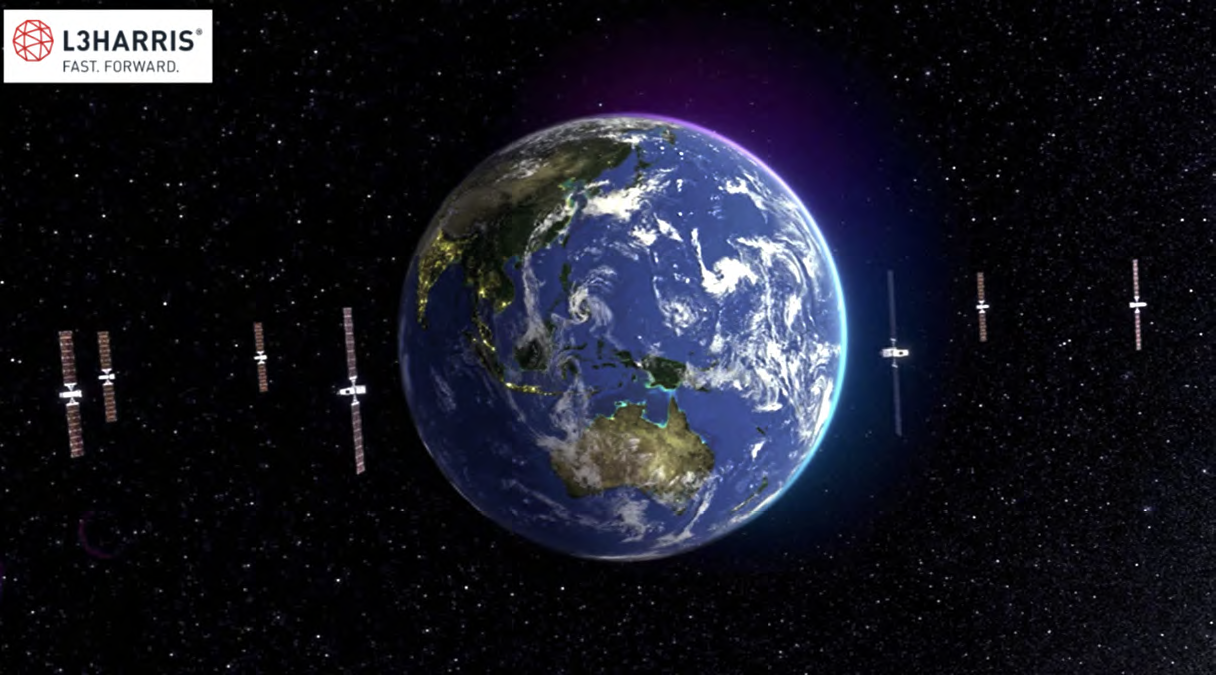Airbus to build the communication network for the French air and naval force, stage 3 Rifan3 - @Marine Nationale
The French Defence Procurement Agency (DGA) has awarded the contract for the IP Network of the Naval Force (RIFAN) stage 3 to an industrial consortium led by Airbus Defence and Space and also comprising Naval Group.

The RIFAN 2 system was commissioned by th Airbus Defence and Space and its partners be and brings together and operates all the comm available on board, such as Syracuse IV, Com satellite constellations (LEO, MEO and GEO
With a maximum value of 480 million euros and a maximum duration of 10 years, the contract covers the development of RIFAN upgrades, their deployment and operational maintenance.
The developments will be carried out incrementally between 2026 and 2030 and deployed on ships between 2028 and 2032.
More than 80 vessels will be equipped with the RIFAN 3 network: aircraft carriers, amphibious helicopter carriers, frigates, command and supply vessels, patrol vessels, minesweepers, submarines and support vessels.
This new RIFAN 3 contract aims, in particular, to increase inter-ship connectivity to progressively meet the needs of collaborative combat, thanks to new high-speed, low-latency transmission means that will be deployed on front-line vessels.
The resilience of the network will also be strengthened by the development of rapid reconfiguration mechanisms to adapt to the available means of communication in different tactical and operational scenarios. In the face of growing cyber threats, the network will also rely on enhanced cybersecurity to preserve the integrity and continuity of operations.
The RIFAN 2 system was commissioned by the French Navy and Airbus Defence and Space and its partners between 2012 and 2016 and brings together and operates all the communication resources available on board, such as Syracuse IV, Comcept, commercial satellite constellations (LEO, MEO and GEO) and radio resources. It allows the vessels to communicate on an IP network guaranteeing a very high level of security, and to exchange data with classification levels ranging from ‘unprotected’ to ‘secret.’
“Airbus Defence and Space has been involved in the development and deployment of the network and communication systems of French Navy ships for almost 15 years,” said Eric Even, Head of Space Digital at Airbus Defence and Space. “With RIFAN 3, we are preparing for the next stage, that of collaborative naval combat, networked combat of all assets and platforms involved in naval operations.”
First AI-enabled PicoSat platform for new space apps for military & defense, public safety, agriculture and more, launches from Aitech
Aitech has introduced a new pico satellite (PicoSat) platform, IQSat. The IQSat is AI-enabled for pattern of life analysis for a range of applications, including public safety, agriculture, military and defense, climate, biology, and more.

Aitech is showcasing the new IQSat PicoSat platform at the National Space Symposium in Colorado Springs, Colorado in booth #612 from April 7-10.
With more than 30 years of electronics in space and trillions of miles flown in space, the new IQSat is built on Aitech’s proven experience. The PicoSat’s affordability allows for redundancy for deploying dozens or hundreds of units to deliver information on any spot on Earth frequently. The IQSat is small enough to be held in the palm of a hand, and with an IQSat constellation, coverage is powerful enough to deliver actionable information rapidly and frequently from any desired point on Earth. The IQSat supports high-order, low-resource learning anomaly detection, enabling new uses across many market segments:
Military and Defense: With a low probability of intercept and low probability of detection, IQSat can deliver critical information on threat locations, directions, and velocities in any area of interest at tactically significant update rates directly to the Warfighter.
Space Situational Awareness: With flexible sensor options and constellation configurations, IQSat brings low-cost capability to detect space debris to prevent space collisions, monitor orbital traffic, detect changes in satellite trajectories or potential anti-satellite threats, and more.
Space Habitat: Placed in vicinity of Space Habitats, IQSat can deliver temperature, radiation levels, and other variables to evaluate structure integrity and health by detecting micro-meteorite impacts or material degradation external to Space Habitats, or external surveillance to detect space debris collision threats.
Public Safety: A low-cost LEO constellation of IQSats can provide rapid detection of remote areas of natural disasters, such as floods, fires, assist in remote search and rescue operations through detection of objects, locations and movement directly to the rescuer, or can monitor infrastructure surveillance of dams, bridges and others.
Agriculture: IQSat can assist farmers by delivering soil, weather, and other critical information rapidly and frequently to help improve crop output. Science and Research: A constellation of IQSats can provide researchers and scientists with a low cost solution for tracking unique weather patterns, monitoring wildlife migrations around a region or the world, tracking ocean currents and wildlife, and many more capabilities.
The IQSat platform development units will be available by Q4 2025 for mission development and ready for LEO flight in Q1 2026.
L3Harris + Shield AI team for autonomy breakthrough
The CSO-3 military observation satellite has been successfully launched by Arianespace atop an Ariane 6 from Europe’s spaceport in French Guiana. Carrying a very-high-resolution optical instrument built by Thales Alenia Space, the joint venture between Thales (67%) and Leonardo (33%), the satellite was developed by prime contractor Airbus Defence & Space for the French defense procurement agency DGA on behalf of the French Air and Space Force’s Space Command, with delegated oversight from the French space agency CNES. (Photo by Satnews.)

The third and last component in the CSO system for France’s MUSIS military program, CSO-3 will provide increased coverage and revisit capabilities to enable more effective conduct of military operations and faster crisis response.
Designed to the most stringent intelligence and defense requirements, CSO-3 is equipped with a cutting-edge instrument developed by Thales Alenia Space. This instrument is the core of the mission, affording exceptional resolution and detail of Earth’s surface. Its unrivaled performance enables it to acquire imagery at extremely high resolution, even in low-light conditions and at night thanks to its infrared capabilities. Its advanced technologies include latest- generation optical systems and ultra-sensitive sensors.
Like the previous Helios 1, Helios 2 and Pleiades satellites, Thales Alenia Space designed strategic equipment for the CSO system, including the solar arrays, very-high-throughput image telemetry systems, and encryption/decryption modules to ensure data security and confidentiality. The company also supplied the system’s telemetry, tracking and control transponders.
“The launch of CSO-3 is a major milestone for French sovereignty in space, both in terms of launch capabilities and satellite technology,” said Hervé Derrey, Thales Alenia Space CEO. “With the completion of this system, France is leading the way in optical space reconnaissance. The CSO system’s exceptional performance is based in particular on the optical instrument built by the teams at Thales Alenia Space and our industry partners. These unique skills in Europe are strategically important and demonstrate our ability to meet the new challenges facing French and European sovereignty.”
Ariane 6 performs first commercial flight with successful launch of CSO-3 satellite
The CSO-3 military observation satellite has been successfully launched by Arianespace atop an Ariane 6 from Europe’s spaceport in French Guiana. Carrying a very-high-resolution optical instrument built by Thales Alenia Space, the joint venture between Thales (67%) and Leonardo (33%), the satellite was developed by prime contractor Airbus Defence & Space for the French defense procurement agency DGA on behalf of the French Air and Space Force’s Space Command, with delegated oversight from the French space agency CNES. (Photo by Satnews.)

The third and last component in the CSO system for France’s MUSIS military program, CSO-3 will provide increased coverage and revisit capabilities to enable more effective conduct of military operations and faster crisis response.
Designed to the most stringent intelligence and defense requirements, CSO-3 is equipped with a cutting-edge instrument developed by Thales Alenia Space. This instrument is the core of the mission, affording exceptional resolution and detail of Earth’s surface. Its unrivaled performance enables it to acquire imagery at extremely high resolution, even in low-light conditions and at night thanks to its infrared capabilities. Its advanced technologies include latest- generation optical systems and ultra-sensitive sensors.
Like the previous Helios 1, Helios 2 and Pleiades satellites, Thales Alenia Space designed strategic equipment for the CSO system, including the solar arrays, very-high-throughput image telemetry systems, and encryption/decryption modules to ensure data security and confidentiality. The company also supplied the system’s telemetry, tracking and control transponders.
“The launch of CSO-3 is a major milestone for French sovereignty in space, both in terms of launch capabilities and satellite technology,” said Hervé Derrey, Thales Alenia Space CEO. “With the completion of this system, France is leading the way in optical space reconnaissance. The CSO system’s exceptional performance is based in particular on the optical instrument built by the teams at Thales Alenia Space and our industry partners. These unique skills in Europe are strategically important and demonstrate our ability to meet the new challenges facing French and European sovereignty.”
Lockheed Martin, Nokia + Verizon advance defense capabilities via 5G.MIL® collaboration
Lockheed Martin (NYSE: LMT), Nokia (NYSE: NOK) and Verizon (NYSE: VZ) have successfully integrated Nokia’s military-grade 5G solutions into Lockheed Martin’s 5G.MIL® Hybrid Base Station (HBS).

This technology advances new capabilities to integrate commercial 5G connections with military communications systems to provide decisive information for national defense. 5G is playing an expanding role in supporting tactical military missions, seamlessly complementing existing battlefield solutions.
In a series of recent demonstrations, Lockheed Martin integrated Nokia’s military-grade 5G solutions into the 5G.MIL Unified Network Solutions ecosystem, including interoperability with Verizon’s network operations and management solutions. These tests successfully integrated traditional tactical communications solutions with 5G using open systems architecture and commercial standards. Leveraging open standards in this way allows for rapid integration of new, advanced capabilities into HBS configurations, ensuring new products and technology solutions are drop-in ready with no risk of vendor lock.
Initial integration was completed with equipment from Nokia’s leading 5G portfolio at Verizon’s Boston Innovation Center and HBS components at Lockheed Martin’s Valley Forge laboratory in Pennsylvania. Final systems integration, testing and demonstration were accomplished at Lockheed Martin’s facility in Ft. Worth, Texas.
The demonstration included HBS connectivity to hybrid user equipment (HUE) that allows users to switch access links between Demonstration advances interoperability of commercial 5G connections with military communications systems—successfully integrated Nokia’s military-grade 5G solutions and Verizon network management capabilities into Lockheed Martin 5G.MIL hybrid base station commercial 5G and tactical LPx waveforms while maintaining uninterrupted user application sessions on an Android user device. LPX designates low-probability-of-detection, interception, exploitation, jamming, geolocation and spoofing.
By integrating the 5G.MIL HBS with Nokia’s 5G solutions, as well as demonstrating interoperability with Verizon’s public 5G network and leveraging their network operations management software, Lockheed Martin and its strategic collaborators are well positioned to bring new levels of performance, scalability, and reliability to military, national security wireless, and ally international defense networks.
This strategic collaboration for Lockheed Martin, Nokia, and Verizon will enable continuing integration of new technology advancements, including incorporation of Nokia’s 5G technology at Lockheed Martin’s 5G.MIL Experimental Network site in Orlando, Florida, joining Verizon’s capabilities already available on-site. With 5G’s low latency, high bandwidth, and secure connectivity, warfighters can leverage real-time data and advanced situational awareness in dynamic operational environments.
The team will continue to refine and enhance technical offerings, including expanding hybrid network testing to include additional user device types, broader tactical communication system interoperability, and secure public-private network configurations. This will create new ways for customers to apply enhanced capabilities to global military, national security, and homeland defense mission areas, giving operators greater connectivity, faster and more reliable wireless networks, and enhanced interoperability in support of Joint All Domain Operations.



